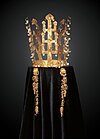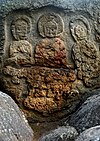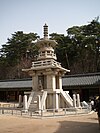Gyeongju Travel Guide
Discover the culturally rich and historically significant city of Gyeongju in South Korea. From ancient tombs to outdoor adventures, this comprehensive guide has everything you need to plan your trip, including top things to see and do, where to stay, and what to eat.
- Introduction to Gyeongju
- List of Places to Visit in Gyeongju
- Hiking/Biking Routes of Gyeongju
- Best Things to Do in Gyeongju: Activities and Tours
- Week-Long Itinerary for Gyeongju
- Food and Drink Scene of Gyeongju
- Where to Stay in Gyeongju: Hotels, Hostels, and Guesthouses
- What to Buy in Gyeongju: Souvenirs and Local Products to Bring Home
- Local Culture and Customs of Gyeongju
- Best Time to Visit Gyeongju
- Do’s and Don’ts of Gyeongju
- Safety and Health
- Getting to Gyeongju: Transportation Options and Logistics
- How to Get Around in Gyeongju
- Where to Go Next from Gyeongju: Nearby Destinations and Excursions
- Conclusion
Introduction to Gyeongju
Gyeongju, also known as the “Museum Without Walls,” is a city located in the North Gyeongsang Province in South Korea. A UNESCO World Heritage site, Gyeongju is famous for its rich cultural heritage, historical significance, ancient tombs, and breathtaking natural scenery. Considered as the spiritual heart of Korea, Gyeongju was the capital of the Silla Dynasty for almost 1,000 years, from 57 BC to 935 AD.
List of Places to Visit in Gyeongju
Culturally Important Attractions: Museums and Historical Places
- Bulguksa Temple: Built-in 774 AD, it is one of the most significant Buddhist temples in South Korea.
- Seokguram Grotto: A UNESCO World Heritage Site, Seokguram Grotto houses a massive Buddha statue and is a masterpiece of Buddhist art.
- Cheomseongdae Observatory: Built-in the 7th century, Cheomseongdae is one of the oldest astronomical observatories in the world.
- Anapji Pond: A former royal garden, Anapji Pond is known for its stunning lotus flowers and serene atmosphere.
- Daereungwon Tomb Complex: Comprising several tombs of the Silla Dynasty’s kings and nobles, Daereungwon Tomb Complex is a must-visit for history buffs.
Natural Attractions of Gyeongju: Outdoor Adventures and Scenic Views
- Namsan Mountain: A popular hiking spot, Namsan Mountain offers spectacular views of Gyeongju and its surroundings.
- Bomun Lake: A man-made lake with a beautiful walking trail, Bomun Lake is an ideal place for a relaxing stroll.
- Gyeongju National Park: A scenic national park with several hiking trails, Gyeongju National Park is home to several ancient temples and burial sites.
Hiking/Biking Routes of Gyeongju
- Hwangnyongsa Temple Course: A challenging hike that takes you through the scenic valleys and ancient temples of Gyeongju.
- Toham Mountain Course: A moderate hike that offers panoramic views of Gyeongju and its surroundings.
- Bulguksa Temple Course: A relatively easy hike that takes you past several Buddhist temples and ruins.
Best Things to Do in Gyeongju: Activities and Tours
- Traditional Korean Tea Ceremony: Experience the art of Korean tea making and tasting in a traditional tea house.
- Silla Palgong Sunrise Tour: Watch the sunrise over the Silla Palgong Mountains and enjoy a delicious traditional Korean breakfast.
- Gyeongju City Highlights Tour: Explore the best historical and cultural sites of Gyeongju with a local guide.
Week-Long Itinerary for Gyeongju
| Day | Activities |
|---|---|
| 1 | Visit Bulguksa Temple and Seokguram Grotto |
| 2 | Hike the Hwangnyongsa Temple Course and explore Daereungwon Tomb Complex |
| 3 | Go on a traditional Korean tea ceremony and visit Cheomseongdae Observatory |
| 4 | Visit Anapji Pond and hike Namsan Mountain |
| 5 | Take a Silla Palgong Sunrise Tour and explore Gyeongju National Park |
| 6 | Visit the Gyeongju National Museum and experience a traditional Korean cooking class |
| 7 | Relax at Bomun Lake and explore the local food and shopping scene |
Food and Drink Scene of Gyeongju
Must-Try Dishes
- Gyeongju Hanjeongsik: A traditional Korean meal served on a tray with rice, soup, and an assortment of side dishes.
- Hwangnam-ppang: A popular snack in Gyeongju, Hwangnam-ppang is a sweet bread filled with red-bean paste.
- Ssambap: A dish consisting of rice and various types of vegetables wrapped in a lettuce leaf.
Local Beverages
- Makgeolli: A traditional Korean rice wine, Makgeolli is mild and slightly sweet.
- Soju: A clear, distilled alcohol, Soju is often served as a shot or mixed with other beverages.
- Jeju Green Tea: A popular tea in Gyeongju, Jeju Green Tea is known for its refreshing taste and health benefits.
Where to Stay in Gyeongju: Hotels, Hostels, and Guesthouses
- Gyeongju Guesthouse: A cozy guesthouse with a traditional Korean atmosphere and friendly staff.
- Kolon Hotel: A luxury hotel with a spa, fitness center, and stunning views of Gyeongju.
- Hwangnam-ri Momoji: A traditional Korean-style guesthouse located in a tranquil neighborhood.
What to Buy in Gyeongju: Souvenirs and Local Products to Bring Home
- Silla Bronze Ware: Handcrafted bronze vessels and ornaments inspired by the Silla Dynasty’s art and culture.
- Gyeongju Hwangnam-ppang: A popular snack in Gyeongju, Hwangnam-ppang makes for a delicious and unique souvenir.
- Traditional Korean Tea: Bring home the taste of Korea with a selection of premium tea blends from Gyeongju.
Local Culture and Customs of Gyeongju
- Korean etiquette: Koreans are known for their formal etiquette and politeness. It is crucial to show respect and avoid offending their culture.
- Traditional Korean dress: The Hanbok is the traditional Korean dress worn on special occasions and cultural events.
- Korean family-oriented culture: Korean society values family and kinship, and it is common for multiple generations to live together in one home.
Best Time to Visit Gyeongju
The best time to visit Gyeongju is during the spring (April to June) and autumn (September to November) when the weather is mild, and there are fewer crowds.
Do’s and Don’ts of Gyeongju
Do:
- Take off your shoes before entering someone’s home or a traditional Korean establishment.
- Respect and follow Korean etiquette and customs.
- Try the local food and drink scene.
Don’t:
- Wear revealing or provocative clothing to cultural and religious sites.
- Disrespect elders or authority figures.
- Smoking in public places.
Safety and Health
Safety in Gyeongju
Gyeongju is a safe and well-maintained city. However, it is recommended to take basic safety precautions like staying aware of your surroundings and avoiding unlit areas at night.
Health in Gyeongju
Medical facilities in Gyeongju are modern and well-equipped. It is advisable to purchase travel insurance before your trip.
Getting to Gyeongju: Transportation Options and Logistics
Airports Near Gyeongju
- Incheon International Airport: The largest airport in South Korea, Incheon International Airport is located about 300 kilometers from Gyeongju and offers direct flights to major cities worldwide.
- Gimhae International Airport: Located in Busan, about 90 kilometers from Gyeongju, Gimhae International Airport offers domestic and international flights to several destinations in Asia.
Bus Stations Near Gyeongju
- Gyeongju Bus Terminal: Located in the center of Gyeongju, this bus terminal offers direct bus services to several major cities in South Korea.
- Singyeongju Bus Terminal: Located in the nearby city of Yeongju, Singyeongju Bus Terminal offers direct bus services to several cities in South Korea.
Other Options
- Train: KTX is a high-speed train service operated by Korail that offers direct services from Seoul to Gyeongju.
- Car Rental: Renting a car is an excellent option for traveling at your own pace and exploring the surrounding areas of Gyeongju.
How to Get Around in Gyeongju
- Taxi: Taxis are readily available in Gyeongju and are an affordable option for short distances.
- Bus: Gyeongju has an extensive bus network with affordable fares and frequent services.
- Bicycle: Renting a bicycle is a popular way to explore the city’s historical sites and scenic views.
Where to Go Next from Gyeongju: Nearby Destinations and Excursions
- Busan: A bustling port city with stunning beaches, delicious seafood, and a vibrant nightlife.
- Seoraksan National Park: A scenic national park located in the nearby province of Gangwon, famous for its impressive mountain range.
- Andong: The home of traditional Korean culture, Andong is famous for its well-preserved Joseon-era houses and its annual Mask Dance Festival.
Conclusion
Gyeongju is a city that offers visitors a glimpse into South Korea’s rich cultural history and natural beauty. With ancient tombs, temples, and historical sites, along with stunning natural scenery and delicious local cuisine, Gyeongju is the perfect destination for travelers looking to experience the best of Korea. By following this comprehensive guide, you will have everything you need to plan your dream trip to Gyeongju.
Gyeongju Image Gallery
 The gold crown from Seobongchong Tumulus, one of the Silla crowns
The gold crown from Seobongchong Tumulus, one of the Silla crowns
 Gyeongju Station
Gyeongju Station
 Singyeongju Station
Singyeongju Station
 Buhwangsa Pagoda
Buhwangsa Pagoda
 Anapji Pond in the evening
Anapji Pond in the evening
 Map of Bulguksa Temple (click to enlarge)
Map of Bulguksa Temple (click to enlarge)
 Main entrance to Bulguksa Temple
Main entrance to Bulguksa Temple
 Seokguram from the outside
Seokguram from the outside
 Gameunsa
Gameunsa
 The burial mound of King Wonseong
The burial mound of King Wonseong
 Buddhas carved into the rock in Tapgok Valley, Namsan Mountain, Gyeongju National Park
Buddhas carved into the rock in Tapgok Valley, Namsan Mountain, Gyeongju National Park
 Seongdong Market
Seongdong Market
 Making "Gyeongju ppang"
Making "Gyeongju ppang"
 Dabotap, a stone pagoda in Bulguksa Temple complex
Dabotap, a stone pagoda in Bulguksa Temple complex
 View of Yangdong Folk Village
View of Yangdong Folk Village
